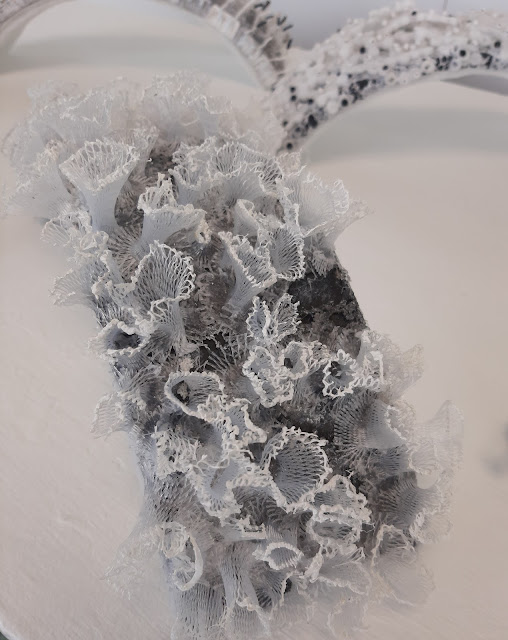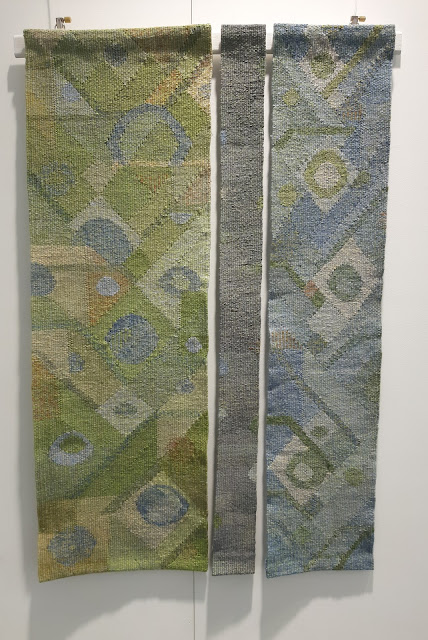What did I enjoy?
Sue Reddish’s masterful use of repurposed clothing to create her pieces about the liminal spaces around and beneath the two miles of the elevated Mancunian Way, which has cut across the city since the 1960s. Her tiny seed stitch in a rich orange in this piece creates a haze of colour as though the background, which I read as sky, was flowing forwards across the land.
In Judith Isaac-Lewis’s wonderful collection of "Nature Pages" botanical prints, made with plants collected from the former railway embankments at St Alban's Way, were enhanced with the most evocative embroideries. I loved each one for the way she used a small selection of stitches which spoke to the natural imagery.
Jane Riley’s tapestry, "The Fortress Cliffs" was inspired by the cliffs at Ravenscar North Yorkshire. I thought her use of differing textures of thread and eccentric weave created a real sense of standing at the edge, looking out, and expressed her hope for the continuing recovery of this space from its industrial past.
The snapshot views in Amanda’s Hislop’s five wall hangings and concertina book perfectly evoked her experience of snatched views and changing seasons while walking in farmland near her home.
Marian Jazmik’s incredibly delicate monochrome pieces using a wide variety of reclaimed materials astonished me. The amount of work it must have taken to produce them was one source of amazement, quickly followed by admiration for her inventive use of mundane objects such as zips to evoke elements of the natural world and of decay which were inspired by her own photographs.
Niki Chandler’s symphony of shining colour was a wonder to behold. Built from multiple layers of fine netting, used for dance costumes, she created a patchwork of square shapes, blending colours carefully by folding and layering her net to construct a dance of changing colour across the dark background.
Anita Bruce's linked woven hangings were inspired by the patchwork patterns of familiar farmlands as they appear on satellite images. Initially she was considering the luxuriant verges she drove past, and their contrast with the unvaried canvas of the fields. When heavy rain flooded the area those fields disappeared; a visual reversal where patches of farmland become small islands in a vast, sky reflecting, lake.
Helen MacRitchie’s pieces are meditations on the way that nature reclaims urban spaces and margins as they become more neglected. Two wall hung artworks contrasted strong green twining strands with underlying patterns evoking urban space.
A freestanding work, suspended from the ceiling, took the contrast of these geometric and organic elements and liberated them into space where one could walk round them and consider from all angles the way nature was inserting herself into the built environment. Glimpses of the outside environment, mixed urban and natural, brought those contrasts to life.
And finally, having saved them until last, I gave myself up to enjoying Kim McCormack’s wonderful eco print embroideries, The Wet Desert, A Trail to Glenurquhart and The Rewilding. She combines so many elements and textures: silky surfaces with tactile velvets; fragments of map with the leafy shapes of eco printing; dense areas of bullion and French knots contrasted with delicate lines of stitch which connect everything together. It was such a pleasure to see them up close, to look carefully at the layering and overlaying of different elements: couched down tubes of soft wool; leafy shapes and patterns creating a counterpoint with more geometrical areas; hand stitch and machine stitch. I marveled at the many hours of planning and stitching that must have gone into making each piece. I loved the way some of the botanical prints disappeared behind the next layer, giving a sense that all was grounded in the natural world. All in all a very inspiring day out
If you would like to know more about what was exhibited there you can download the exhibition catalogue from the Prism website here. It's well worth a browse and the site also has links to all of their members
































